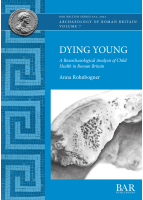Description
‘Dying Young’ explores childhood morbidity and mortality during the 1st to 5th century AD. The detailed osteological analysis of 953 non-adult (0 - 17 years) skeletons from 15 sites paints a rich picture of the lived realities of Romano-British children in towns and settlements of the countryside. Health and disease are examined under the themes of infant mortality, growth, diet, working lives, infection, access to resources and exploitation. Skeletal evidence indicates higher status of the urban population, which is in stark contrast to nutritional stress and a tough living environment in the countryside. The data suggests exploitation of the rural indigenous population, as well as rural-to-urban migration of adolescents, potentially in the search of work. Patterns in Romano-British childhood health are considered in context by comparison with similar studies for Iron Age and post-medieval periods. This volume highlights the importance of skeletons, particularly those of non-adults, as a multi-faceted resource for understanding the forgotten and marginalised people of Roman Britain.
AUTHOR
Anna Rohnbogner completed her PhD at the University of Reading in 2015 and worked as a post-doctoral researcher on the Roman Rural Settlement Project. She is currently a Visiting Research Fellow at the School of Archaeology at the University of Reading.
REVIEWS
‘Dying Young, the seventh volume in BAR’s series Archaeology of Roman Britain, showcases how bioarchaeology has matured in the past decade to take up social theory and interface with broader discussions such as the im-pacts of urbanization, the rise of social inequality, and, central to this book, the realities of migrant and child labor.’ John J. Crandall, American Journal of Archaeology, Vol 128, January 2024
‘This volume provides extensive osteological and paleopathological discussions of the current literature on the Romano-British period and contributes information on weaning, growth, diet, working-lives, and mortality in rural and urban living. The volume is recommended to all those who wish to learn about past societies sociocultural lifeways and the health and disease of non-adults.’ Stephie R. Lončar, Childhood in the Past, Vol 16 (1), 2023
‘Dying Young is an important addition to an ever-growing body of literature. Resoundingly unique in scope and extraordinarily detailed, this volume is the first to provide a thorough assessment of childhood health in Roman Britain.’ Claire Hodson, Current Archaeology, November 2022
‘This book is unique. No other researcher has collated data from across Roman Britain in this way. It provides many new insights into the lives of children in Roman Britain and is invaluable to Roman bioarchaeology.’ Dr Rebecca Redfern, Museum of London
‘The primary data and re-analysis covers an extraordinary number of individual skeletons from Roman Britain, and has been able to identify new cases of rare diseases that are incredibly valuable to the subject area, as well as create a more general picture of health and development during the Roman period, which also benefits other researchers in this area.’ Dr Rebecca Watts, University College London











